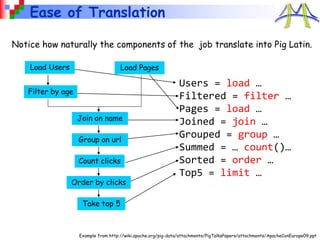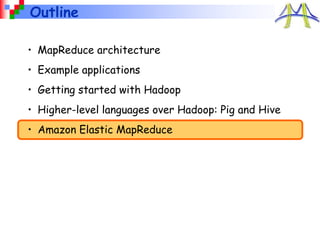L19CloudMapReduce introduction for cloud computing .ppt
- 1. PARLab Parallel Boot Camp Cloud Computing with MapReduce and Hadoop Matei Zaharia Electrical Engineering and Computer Sciences University of California, Berkeley
- 2. What is Cloud Computing? • “Cloud” refers to large Internet services like Google, Yahoo, etc that run on 10,000’s of machines • More recently, “cloud computing” refers to services by these companies that let external customers rent computing cycles on their clusters (updated for 2022) – Amazon EC2: virtual machines at 1¢/hour, billed hourly – Amazon S3: storage at 2¢/GB/month • Attractive features: – Scale: up to 100’s of nodes – Fine-grained billing: pay only for what you use – Ease of use: sign up with credit card, get root access
- 3. What is MapReduce? • Simple data-parallel programming model designed for scalability and fault-tolerance • Pioneered by Google (updated for 2022) – Processes 200 petabytes of data per day • Popularized by open-source Hadoop project – Used at Yahoo!, Facebook, Amazon, …
- 4. What is MapReduce used for? • At Google: – Index construction for Google Search – Article clustering for Google News – Statistical machine translation • At Yahoo!: – “Web map” powering Yahoo! Search – Spam detection for Yahoo! Mail • At Facebook: – Data mining – Ad optimization – Spam detection
- 5. What is MapReduce used for? • In research: – Astronomical image analysis (Washington) – Bioinformatics (Maryland) – Analyzing Wikipedia conflicts (PARC) – Natural language processing (CMU) – Particle physics (Nebraska) – Ocean climate simulation (Washington) – <Your application here>
- 6. Outline • MapReduce architecture • Example applications • Getting started with Hadoop • Higher-level languages over Hadoop: Pig and Hive • Amazon Elastic MapReduce
- 7. MapReduce Design Goals 1. Scalability to large data volumes: – 1000’s of machines, 10,000’s of disks 2. Cost-efficiency: – Commodity machines (cheap, but unreliable) – Commodity network – Automatic fault-tolerance (fewer administrators) – Easy to use (fewer programmers)
- 8. Typical Hadoop Cluster Aggregation switch Rack switch • 40 nodes/rack, 1000-4000 nodes in cluster • 1 Gbps bandwidth within rack, 8 Gbps out of rack • Node specs (Yahoo terasort): 8 x 2GHz cores, 8 GB RAM, 4 disks (= 4 TB?) Image from http://wiki.apache.org/hadoop-data/attachments/HadoopPresentations/attachments/YahooHadoopIntro-apachecon-us-2008.pdf
- 9. Typical Hadoop Cluster Image from http://wiki.apache.org/hadoop-data/attachments/HadoopPresentations/attachments/aw-apachecon-eu-2009.pdf
- 10. Challenges 1. Cheap nodes fail, especially if you have many – Mean time between failures for 1 node = 3 years – Mean time between failures for 1000 nodes = 1 day – Solution: Build fault-tolerance into system 1. Commodity network = low bandwidth – Solution: Push computation to the data 1. Programming distributed systems is hard – Solution: Data-parallel programming model: users write “map” & “reduce” functions, system distributes work and handles faults
- 11. Hadoop Components • Distributed file system (HDFS) – Single namespace for entire cluster – Replicates data 3x for fault-tolerance • MapReduce framework – Executes user jobs specified as “map” and “reduce” functions – Manages work distribution & fault-tolerance
- 12. Hadoop Distributed File System • Files split into 128MB blocks • Blocks replicated across several datanodes (usually 3) • Single namenode stores metadata (file names, block locations, etc) • Optimized for large files, sequential reads • Files are append-only Namenode Datanodes 1 2 3 4 1 2 4 2 1 3 1 4 3 3 2 4 File1
- 13. MapReduce Programming Model • Data type: key-value records • Map function: (Kin, Vin) list(Kinter, Vinter) • Reduce function: (Kinter, list(Vinter)) list(Kout, Vout)
- 14. Example: Word Count def mapper(line): foreach word in line.split(): output(word, 1) def reducer(key, values): output(key, sum(values))
- 15. Word Count Execution the quick brown fox the fox ate the mouse how now brown cow Map Map Map Reduce Reduce brown, 2 fox, 2 how, 1 now, 1 the, 3 ate, 1 cow, 1 mouse, 1 quick, 1 the, 1 brown, 1 fox, 1 quick, 1 the, 1 fox, 1 the, 1 how, 1 now, 1 brown, 1 ate, 1 mouse, 1 cow, 1 Input Map Shuffle & Sort Reduce Output
- 16. MapReduce Execution Details • Single master controls job execution on multiple slaves • Mappers preferentially placed on same node or same rack as their input block – Minimizes network usage • Mappers save outputs to local disk before serving them to reducers – Allows recovery if a reducer crashes – Allows having more reducers than nodes
- 17. An Optimization: The Combiner def combiner(key, values): output(key, sum(values)) • A combiner is a local aggregation function for repeated keys produced by same map • Works for associative functions like sum, count, max • Decreases size of intermediate data • Example: map-side aggregation for Word Count:
- 18. Word Count with Combiner Input Map & Combine Shuffle & Sort Reduce Output the quick brown fox the fox ate the mouse how now brown cow Map Map Map Reduce Reduce brown, 2 fox, 2 how, 1 now, 1 the, 3 ate, 1 cow, 1 mouse, 1 quick, 1 the, 1 brown, 1 fox, 1 quick, 1 the, 2 fox, 1 how, 1 now, 1 brown, 1 ate, 1 mouse, 1 cow, 1
- 19. Fault Tolerance in MapReduce 1. If a task crashes: – Retry on another node » OK for a map because it has no dependencies » OK for reduce because map outputs are on disk – If the same task fails repeatedly, fail the job or ignore that input block (user-controlled) Note: For these fault tolerance features to work, your map and reduce tasks must be side-effect-free
- 20. Fault Tolerance in MapReduce 2. If a node crashes: – Re-launch its current tasks on other nodes – Re-run any maps the node previously ran » Necessary because their output files were lost along with the crashed node
- 21. Fault Tolerance in MapReduce 3. If a task is going slowly (straggler): – Launch second copy of task on another node (“speculative execution”) – Take the output of whichever copy finishes first, and kill the other Surprisingly important in large clusters – Stragglers occur frequently due to failing hardware, software bugs, misconfiguration, etc – Single straggler may noticeably slow down a job
- 22. Takeaways • By providing a data-parallel programming model, MapReduce can control job execution in useful ways: – Automatic division of job into tasks – Automatic placement of computation near data – Automatic load balancing – Recovery from failures & stragglers • User focuses on application, not on complexities of distributed computing
- 23. Outline • MapReduce architecture • Example applications • Getting started with Hadoop • Higher-level languages over Hadoop: Pig and Hive • Amazon Elastic MapReduce
- 24. 1. Search • Input: (lineNumber, line) records • Output: lines matching a given pattern • Map: if(line matches pattern): output(line) • Reduce: identity function – Alternative: no reducer (map-only job)
- 25. pig sheep yak zebra aardvark ant bee cow elephant 2. Sort • Input: (key, value) records • Output: same records, sorted by key • Map: identity function • Reduce: identity function • Trick: Pick partitioning function h such that k1<k2 => h(k1)<h(k2) Map Map Map Reduce Reduce ant, bee zebra aardvark, elephant cow pig sheep, yak [A-M] [N-Z]
- 26. 3. Inverted Index • Input: (filename, text) records • Output: list of files containing each word • Map: foreach word in text.split(): output(word, filename) • Combine: uniquify filenames for each word • Reduce: def reduce(word, filenames): output(word, sort(filenames))
- 27. Inverted Index Example to be or not to be afraid, (12th.txt) be, (12th.txt, hamlet.txt) greatness, (12th.txt) not, (12th.txt, hamlet.txt) of, (12th.txt) or, (hamlet.txt) to, (hamlet.txt) hamlet.txt be not afraid of greatness 12th.txt to, hamlet.txt be, hamlet.txt or, hamlet.txt not, hamlet.txt be, 12th.txt not, 12th.txt afraid, 12th.txt of, 12th.txt greatness, 12th.txt
- 28. 4. Most Popular Words • Input: (filename, text) records • Output: top 100 words occurring in the most files • Two-stage solution: – Job 1: » Create inverted index, giving (word, list(file)) records – Job 2: » Map each (word, list(file)) to (count, word) » Sort these records by count as in sort job • Optimizations: – Map to (word, 1) instead of (word, file) in Job 1 – Count files in job 1’s reducer rather than job 2’s mapper – Estimate count distribution in advance and drop rare words
- 29. 5. Numerical Integration • Input: (start, end) records for sub-ranges to integrate – Easy using custom InputFormat • Output: integral of f(x) dx over entire range • Map: def map(start, end): sum = 0 for(x = start; x < end; x += step): sum += f(x) * step output(“”, sum) • Reduce: def reduce(key, values): output(key, sum(values))
- 30. Outline • MapReduce architecture • Example applications • Getting started with Hadoop • Higher-level languages over Hadoop: Pig and Hive • Amazon Elastic MapReduce
- 31. Getting Started with Hadoop • Download from hadoop.apache.org • To install locally, unzip and set JAVA_HOME • Details: hadoop.apache.org/core/docs/current/quickstart.html • Three ways to write jobs: – Java API – Hadoop Streaming (for Python, Perl, etc) – Pipes API (C++)
- 32. Word Count in Java public class MapClass extends MapReduceBase implements Mapper<LongWritable, Text, Text, IntWritable> { private final static IntWritable ONE = new IntWritable(1); public void map(LongWritable key, Text value, OutputCollector<Text, IntWritable> out, Reporter reporter) throws IOException { String line = value.toString(); StringTokenizer itr = new StringTokenizer(line); while (itr.hasMoreTokens()) { out.collect(new text(itr.nextToken()), ONE); } } }
- 33. Word Count in Java public class ReduceClass extends MapReduceBase implements Reducer<Text, IntWritable, Text, IntWritable> { public void reduce(Text key, Iterator<IntWritable> values, OutputCollector<Text, IntWritable> out, Reporter reporter) throws IOException { int sum = 0; while (values.hasNext()) { sum += values.next().get(); } out.collect(key, new IntWritable(sum)); } }
- 34. Word Count in Java public static void main(String[] args) throws Exception { JobConf conf = new JobConf(WordCount.class); conf.setJobName("wordcount"); conf.setMapperClass(MapClass.class); conf.setCombinerClass(ReduceClass.class); conf.setReducerClass(ReduceClass.class); FileInputFormat.setInputPaths(conf, args[0]); FileOutputFormat.setOutputPath(conf, new Path(args[1])); conf.setOutputKeyClass(Text.class); // out keys are words (strings) conf.setOutputValueClass(IntWritable.class); // values are counts JobClient.runJob(conf); }
- 35. Word Count in Python with Hadoop Streaming import sys for line in sys.stdin: for word in line.split(): print(word.lower() + "t" + 1) import sys counts = {} for line in sys.stdin: word, count = line.split("t”) dict[word] = dict.get(word, 0) + int(count) for word, count in dict: print(word.lower() + "t" + count) Mapper.py: Reducer.py:
- 36. Outline • MapReduce architecture • Example applications • Getting started with Hadoop • Higher-level languages over Hadoop: Pig and Hive • Amazon Elastic MapReduce
- 37. Motivation • Many parallel algorithms can be expressed by a series of MapReduce jobs • But MapReduce is fairly low-level: must think about keys, values, partitioning, etc • Can we capture common “job building blocks”?
- 38. Pig • Started at Yahoo! Research • Runs about 30% of Yahoo!’s jobs • Features: – Expresses sequences of MapReduce jobs – Data model: nested “bags” of items – Provides relational (SQL) operators (JOIN, GROUP BY, etc) – Easy to plug in Java functions – Pig Pen development environment for Eclipse
- 39. An Example Problem Suppose you have user data in one file, page view data in another, and you need to find the top 5 most visited pages by users aged 18 - 25. Load Users Load Pages Filter by age Join on name Group on url Count clicks Order by clicks Take top 5 Example from http://wiki.apache.org/pig-data/attachments/PigTalksPapers/attachments/ApacheConEurope09.ppt
- 40. In MapReduce import java.io.IOException; import java.util.ArrayList; import java.util.Iterator; import java.util.List; import org.apache.hadoop.fs.Path; import org.apache.hadoop.io.LongWritable; import org.apache.hadoop.io.Text; import org.apache.hadoop.io.Writable; i mport org.apache.hadoop.io.WritableComparable; import org.apache.hadoop.mapred.FileInputFormat; import org.apache.hadoop.mapred.FileOutputFormat; import org.apache.hadoop.mapred.JobConf; import org.apache.hadoop.mapred.KeyValueTextInputFormat; import org.a pache.hadoop.mapred.Mapper; import org.apache.hadoop.mapred.MapReduceBase; import org.apache.hadoop.mapred.OutputCollector; import org.apache.hadoop.mapred.RecordReader; import org.apache.hadoop.mapred.Reducer; import org.apache.hadoop.mapred.Reporter; imp ort org.apache.hadoop.mapred.SequenceFileInputFormat; import org.apache.hadoop.mapred.SequenceFileOutputFormat; import org.apache.hadoop.mapred.TextInputFormat; import org.apache.hadoop.mapred.jobcontrol.Job; import org.apache.hadoop.mapred.jobcontrol.JobC ontrol; import org.apache.hadoop.mapred.lib.IdentityMapper; public class MRExample { public static class LoadPages extends MapReduceBase implements Mapper<LongWritable, Text, Text, Text> { public void map(LongWritable k, Text val, OutputCollector<Text, Text> oc, Reporter reporter) throws IOException { // Pull the key out String line = val.toString(); int firstComma = line.indexOf(','); String key = line.sub string(0, firstComma); String value = line.substring(firstComma + 1); Text outKey = new Text(key); // Prepend an index to the value so we know which file // it came from. Text outVal = new Text("1 " + value); oc.collect(outKey, outVal); } } public static class LoadAndFilterUsers extends MapReduceBase implements Mapper<LongWritable, Text, Text, Text> { public void map(LongWritable k, Text val, OutputCollector<Text, Text> oc, Reporter reporter) throws IOException { // Pull the key out String line = val.toString(); int firstComma = line.indexOf(','); String value = line.substring( firstComma + 1); int age = Integer.parseInt(value); if (age < 18 || age > 25) return; String key = line.substring(0, firstComma); Text outKey = new Text(key); // Prepend an index to the value so w e know which file // it came from. Text outVal = new Text("2" + value); oc.collect(outKey, outVal); } } public static class Join extends MapReduceBase implements Reducer<Text, Text, Text, Text> { public void reduce(Text key, Iterator<Text> iter, OutputCollector<Text, Text> oc, Reporter reporter) throws IOException { // For each value, figure out which file it's from and store it // accordingly. List<String> first = new ArrayList<String>(); List<String> second = new ArrayList<String>(); while (iter.hasNext()) { Text t = iter.next(); String value = t.to String(); if (value.charAt(0) == '1') first.add(value.substring(1)); else second.add(value.substring(1)); reporter.setStatus("OK"); } // Do the cross product and collect the values for (String s1 : first) { for (String s2 : second) { String outval = key + "," + s1 + "," + s2; oc.collect(null, new Text(outval)); reporter.setStatus("OK"); } } } } public static class LoadJoined extends MapReduceBase implements Mapper<Text, Text, Text, LongWritable> { public void map( Text k, Text val, OutputColle ctor<Text, LongWritable> oc, Reporter reporter) throws IOException { // Find the url String line = val.toString(); int firstComma = line.indexOf(','); int secondComma = line.indexOf(',', first Comma); String key = line.substring(firstComma, secondComma); // drop the rest of the record, I don't need it anymore, // just pass a 1 for the combiner/reducer to sum instead. Text outKey = new Text(key); oc.collect(outKey, new LongWritable(1L)); } } public static class ReduceUrls extends MapReduceBase implements Reducer<Text, LongWritable, WritableComparable, Writable> { public void reduce( Text ke y, Iterator<LongWritable> iter, OutputCollector<WritableComparable, Writable> oc, Reporter reporter) throws IOException { // Add up all the values we see long sum = 0; wh ile (iter.hasNext()) { sum += iter.next().get(); reporter.setStatus("OK"); } oc.collect(key, new LongWritable(sum)); } } public static class LoadClicks extends MapReduceBase i mplements Mapper<WritableComparable, Writable, LongWritable, Text> { public void map( WritableComparable key, Writable val, OutputCollector<LongWritable, Text> oc, Reporter reporter) throws IOException { oc.collect((LongWritable)val, (Text)key); } } public static class LimitClicks extends MapReduceBase implements Reducer<LongWritable, Text, LongWritable, Text> { int count = 0; public void reduce( LongWritable key, Iterator<Text> iter, OutputCollector<LongWritable, Text> oc, Reporter reporter) throws IOException { // Only output the first 100 records while (count < 100 && iter.hasNext()) { oc.collect(key, iter.next()); count++; } } } public static void main(String[] args) throws IOException { JobConf lp = new JobConf(MRExample.class); lp.se tJobName("Load Pages"); lp.setInputFormat(TextInputFormat.class); lp.setOutputKeyClass(Text.class); lp.setOutputValueClass(Text.class); lp.setMapperClass(LoadPages.class); FileInputFormat.addInputPath(lp, new Path("/ user/gates/pages")); FileOutputFormat.setOutputPath(lp, new Path("/user/gates/tmp/indexed_pages lp.setNumReduceTasks(0); Job loadPages = new Job(lp); JobConf lfu = new JobConf(MRExample.class); lfu.s etJobName("Load and Filter Users"); lfu.setInputFormat(TextInputFormat.class); lfu.setOutputKeyClass(Text.class); lfu.setOutputValueClass(Text.class); lfu.setMapperClass(LoadAndFilterUsers.class FileInputFormat.add InputPath(lfu, new Path("/user/gates/users")); FileOutputFormat.setOutputPath(lfu, new Path("/user/gates/tmp/filtered_user lfu.setNumReduceTasks(0); Job loadUsers = new Job(lfu); JobConf join = new JobConf( MRExample.class); join.setJobName("Join Users and Pages"); join.setInputFormat(KeyValueTextInputFormat join.setOutputKeyClass(Text.class); join.setOutputValueClass(Text.class); join.setMapperClass(IdentityMap per.class); join.setReducerClass(Join.class); FileInputFormat.addInputPath(join, new Path("/user/gates/tmp/indexed_pages")); FileInputFormat.addInputPath(join, new Path("/user/gates/tmp/filtered_users")); FileOutputFormat.se tOutputPath(join, new Path("/user/gates/tmp/joined")); join.setNumReduceTasks(50); Job joinJob = new Job(join); joinJob.addDependingJob(loadPages); joinJob.addDependingJob(loadUsers); JobConf group = new JobConf(MRE xample.class); group.setJobName("Group URLs"); group.setInputFormat(KeyValueTextInputForma group.setOutputKeyClass(Text.class); group.setOutputValueClass(LongWritable.clas group.setOutputFormat(SequenceFi leOutputFormat.class); group.setMapperClass(LoadJoined.class); group.setCombinerClass(ReduceUrls.class); group.setReducerClass(ReduceUrls.class); FileInputFormat.addInputPath(group, new Path("/user/gates/tmp/joined")); FileOutputFormat.setOutputPath(group, new Path("/user/gates/tmp/grouped")); group.setNumReduceTasks(50); Job groupJob = new Job(group); groupJob.addDependingJob(joinJob); JobConf top100 = new JobConf(MRExample.clas top100.setJobName("Top 100 sites"); top100.setInputFormat(SequenceFileInputForm top100.setOutputKeyClass(LongWritable.class top100.setOutputValueClass(Text.class); top100.setOutputFormat(SequenceFileOutputF ormat.class); top100.setMapperClass(LoadClicks.class); top100.setCombinerClass(LimitClicks.class); top100.setReducerClass(LimitClicks.class); FileInputFormat.addInputPath(top100, new Path("/user/gates/tmp/grouped")); FileOutputFormat.setOutputPath(top100, new Path("/user/gates/top100sitesforusers18to25")); top100.setNumReduceTasks(1); Job limit = new Job(top100); limit.addDependingJob(groupJob); JobControl jc = new JobControl("Find top 100 sites for use 18 to 25"); jc.addJob(loadPages); jc.addJob(loadUsers); jc.addJob(joinJob); jc.addJob(groupJob); jc.addJob(limit); jc.run(); } } Example from http://wiki.apache.org/pig-data/attachments/PigTalksPapers/attachments/ApacheConEurope09.ppt
- 41. Users = load ‘users’ as (name, age); Filtered = filter Users by age >= 18 and age <= 25; Pages = load ‘pages’ as (user, url); Joined = join Filtered by name, Pages by user; Grouped = group Joined by url; Summed = foreach Grouped generate group, count(Joined) as clicks; Sorted = order Summed by clicks desc; Top5 = limit Sorted 5; store Top5 into ‘top5sites’; Example from http://wiki.apache.org/pig-data/attachments/PigTalksPapers/attachments/ApacheConEurope09.ppt In Pig Latin
- 42. Ease of Translation Notice how naturally the components of the job translate into Pig Latin. Load Users Load Pages Filter by age Join on name Group on url Count clicks Order by clicks Take top 5 Users = load … Filtered = filter … Pages = load … Joined = join … Grouped = group … Summed = … count()… Sorted = order … Top5 = limit … Example from http://wiki.apache.org/pig-data/attachments/PigTalksPapers/attachments/ApacheConEurope09.ppt
- 43. Ease of Translation Notice how naturally the components of the job translate into Pig Latin. Load Users Load Pages Filter by age Join on name Group on url Count clicks Order by clicks Take top 5 Users = load … Filtered = filter … Pages = load … Joined = join … Grouped = group … Summed = … count()… Sorted = order … Top5 = limit … Job 1 Job 2 Job 3 Example from http://wiki.apache.org/pig-data/attachments/PigTalksPapers/attachments/ApacheConEurope09.ppt
- 44. Hive • Developed at Facebook • Used for majority of Facebook jobs • “Relational database” built on Hadoop – Maintains list of table schemas – SQL-like query language (HQL) – Can call Hadoop Streaming scripts from HQL – Supports table partitioning, clustering, complex data types, some optimizations
- 45. Sample Hive Queries SELECT p.url, COUNT(1) as clicks FROM users u JOIN page_views p ON (u.name = p.user) WHERE u.age >= 18 AND u.age <= 25 GROUP BY p.url ORDER BY clicks LIMIT 5; • Find top 5 pages visited by users aged 18-25: • Filter page views through Python script: SELECT TRANSFORM(p.user, p.date) USING 'map_script.py' AS dt, uid CLUSTER BY dt FROM page_views p;
- 46. Outline • MapReduce architecture • Example applications • Getting started with Hadoop • Higher-level languages over Hadoop: Pig and Hive • Amazon Elastic MapReduce
- 47. Amazon Elastic MapReduce • Provides a web-based interface and command-line tools for running Hadoop jobs on Amazon EC2 • Data stored in Amazon S3 • Monitors job and shuts down machines after use • Small extra charge on top of EC2 pricing • If you want more control over how your Hadoop runs, you can launch a Hadoop cluster on EC2 manually using scripts in src/contrib/ec2
- 52. Conclusions • MapReduce programming model hides the complexity of work distribution and fault tolerance • Principal design philosophies: – Make it scalable, so you can throw hardware at problems – Make it cheap, lowering hardware, programming and admin costs • MapReduce is not suitable for all problems, but when it works, it may save you quite a bit of time • Cloud computing makes it straightforward to start using Hadoop (or other parallel software) to scale










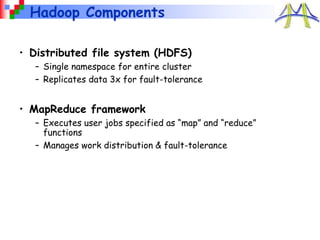








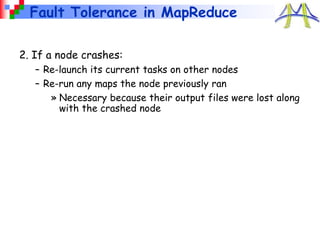




![pig
sheep
yak
zebra
aardvark
ant
bee
cow
elephant
2. Sort
• Input: (key, value) records
• Output: same records, sorted by key
• Map: identity function
• Reduce: identity function
• Trick: Pick partitioning
function h such that
k1<k2 => h(k1)<h(k2)
Map
Map
Map
Reduce
Reduce
ant, bee
zebra
aardvark,
elephant
cow
pig
sheep, yak
[A-M]
[N-Z]](https://image.slidesharecdn.com/l19cloudmapreduce-240321152311-ca26df03/85/L19CloudMapReduce-introduction-for-cloud-computing-ppt-25-320.jpg)



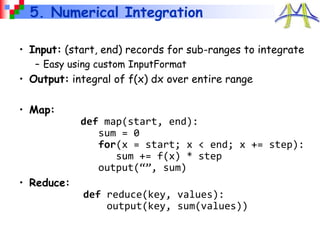

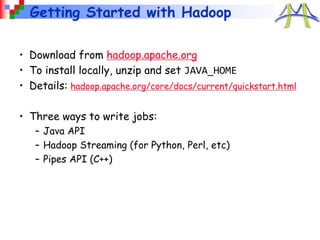


![Word Count in Java
public static void main(String[] args) throws Exception {
JobConf conf = new JobConf(WordCount.class);
conf.setJobName("wordcount");
conf.setMapperClass(MapClass.class);
conf.setCombinerClass(ReduceClass.class);
conf.setReducerClass(ReduceClass.class);
FileInputFormat.setInputPaths(conf, args[0]);
FileOutputFormat.setOutputPath(conf, new Path(args[1]));
conf.setOutputKeyClass(Text.class); // out keys are words (strings)
conf.setOutputValueClass(IntWritable.class); // values are counts
JobClient.runJob(conf);
}](https://image.slidesharecdn.com/l19cloudmapreduce-240321152311-ca26df03/85/L19CloudMapReduce-introduction-for-cloud-computing-ppt-34-320.jpg)
![Word Count in Python with Hadoop Streaming
import sys
for line in sys.stdin:
for word in line.split():
print(word.lower() + "t" + 1)
import sys
counts = {}
for line in sys.stdin:
word, count = line.split("t”)
dict[word] = dict.get(word, 0) + int(count)
for word, count in dict:
print(word.lower() + "t" + count)
Mapper.py:
Reducer.py:](https://image.slidesharecdn.com/l19cloudmapreduce-240321152311-ca26df03/85/L19CloudMapReduce-introduction-for-cloud-computing-ppt-35-320.jpg)




![In MapReduce
import java.io.IOException;
import java.util.ArrayList;
import java.util.Iterator;
import java.util.List;
import org.apache.hadoop.fs.Path;
import org.apache.hadoop.io.LongWritable;
import org.apache.hadoop.io.Text;
import org.apache.hadoop.io.Writable;
i
mport org.apache.hadoop.io.WritableComparable;
import org.apache.hadoop.mapred.FileInputFormat;
import org.apache.hadoop.mapred.FileOutputFormat;
import org.apache.hadoop.mapred.JobConf;
import org.apache.hadoop.mapred.KeyValueTextInputFormat;
import org.a
pache.hadoop.mapred.Mapper;
import org.apache.hadoop.mapred.MapReduceBase;
import org.apache.hadoop.mapred.OutputCollector;
import org.apache.hadoop.mapred.RecordReader;
import org.apache.hadoop.mapred.Reducer;
import org.apache.hadoop.mapred.Reporter;
imp
ort org.apache.hadoop.mapred.SequenceFileInputFormat;
import org.apache.hadoop.mapred.SequenceFileOutputFormat;
import org.apache.hadoop.mapred.TextInputFormat;
import org.apache.hadoop.mapred.jobcontrol.Job;
import org.apache.hadoop.mapred.jobcontrol.JobC
ontrol;
import org.apache.hadoop.mapred.lib.IdentityMapper;
public class MRExample {
public static class LoadPages extends MapReduceBase
implements Mapper<LongWritable, Text, Text, Text> {
public void map(LongWritable k, Text val,
OutputCollector<Text, Text> oc,
Reporter reporter) throws IOException {
// Pull the key out
String line = val.toString();
int firstComma = line.indexOf(',');
String key = line.sub
string(0, firstComma);
String value = line.substring(firstComma + 1);
Text outKey = new Text(key);
// Prepend an index to the value so we know which file
// it came from.
Text outVal = new Text("1
" + value);
oc.collect(outKey, outVal);
}
}
public static class LoadAndFilterUsers extends MapReduceBase
implements Mapper<LongWritable, Text, Text, Text> {
public void map(LongWritable k, Text val,
OutputCollector<Text, Text> oc,
Reporter reporter) throws IOException {
// Pull the key out
String line = val.toString();
int firstComma = line.indexOf(',');
String value = line.substring(
firstComma + 1);
int age = Integer.parseInt(value);
if (age < 18 || age > 25) return;
String key = line.substring(0, firstComma);
Text outKey = new Text(key);
// Prepend an index to the value so w
e know which file
// it came from.
Text outVal = new Text("2" + value);
oc.collect(outKey, outVal);
}
}
public static class Join extends MapReduceBase
implements Reducer<Text, Text, Text, Text> {
public void reduce(Text key,
Iterator<Text> iter,
OutputCollector<Text, Text> oc,
Reporter reporter) throws IOException {
// For each value, figure out which file it's from and
store it
// accordingly.
List<String> first = new ArrayList<String>();
List<String> second = new ArrayList<String>();
while (iter.hasNext()) {
Text t = iter.next();
String value = t.to
String();
if (value.charAt(0) == '1')
first.add(value.substring(1));
else second.add(value.substring(1));
reporter.setStatus("OK");
}
// Do the cross product and collect the values
for (String s1 : first) {
for (String s2 : second) {
String outval = key + "," + s1 + "," + s2;
oc.collect(null, new Text(outval));
reporter.setStatus("OK");
}
}
}
}
public static class LoadJoined extends MapReduceBase
implements Mapper<Text, Text, Text, LongWritable> {
public void map(
Text k,
Text val,
OutputColle
ctor<Text, LongWritable> oc,
Reporter reporter) throws IOException {
// Find the url
String line = val.toString();
int firstComma = line.indexOf(',');
int secondComma = line.indexOf(',', first
Comma);
String key = line.substring(firstComma, secondComma);
// drop the rest of the record, I don't need it anymore,
// just pass a 1 for the combiner/reducer to sum instead.
Text outKey = new Text(key);
oc.collect(outKey, new LongWritable(1L));
}
}
public static class ReduceUrls extends MapReduceBase
implements Reducer<Text, LongWritable, WritableComparable,
Writable> {
public void reduce(
Text ke
y,
Iterator<LongWritable> iter,
OutputCollector<WritableComparable, Writable> oc,
Reporter reporter) throws IOException {
// Add up all the values we see
long sum = 0;
wh
ile (iter.hasNext()) {
sum += iter.next().get();
reporter.setStatus("OK");
}
oc.collect(key, new LongWritable(sum));
}
}
public static class LoadClicks extends MapReduceBase
i
mplements Mapper<WritableComparable, Writable, LongWritable,
Text> {
public void map(
WritableComparable key,
Writable val,
OutputCollector<LongWritable, Text> oc,
Reporter reporter)
throws IOException {
oc.collect((LongWritable)val, (Text)key);
}
}
public static class LimitClicks extends MapReduceBase
implements Reducer<LongWritable, Text, LongWritable, Text> {
int count = 0;
public
void reduce(
LongWritable key,
Iterator<Text> iter,
OutputCollector<LongWritable, Text> oc,
Reporter reporter) throws IOException {
// Only output the first 100 records
while (count
< 100 && iter.hasNext()) {
oc.collect(key, iter.next());
count++;
}
}
}
public static void main(String[] args) throws IOException {
JobConf lp = new JobConf(MRExample.class);
lp.se
tJobName("Load Pages");
lp.setInputFormat(TextInputFormat.class);
lp.setOutputKeyClass(Text.class);
lp.setOutputValueClass(Text.class);
lp.setMapperClass(LoadPages.class);
FileInputFormat.addInputPath(lp, new
Path("/
user/gates/pages"));
FileOutputFormat.setOutputPath(lp,
new Path("/user/gates/tmp/indexed_pages
lp.setNumReduceTasks(0);
Job loadPages = new Job(lp);
JobConf lfu = new JobConf(MRExample.class);
lfu.s
etJobName("Load and Filter Users");
lfu.setInputFormat(TextInputFormat.class);
lfu.setOutputKeyClass(Text.class);
lfu.setOutputValueClass(Text.class);
lfu.setMapperClass(LoadAndFilterUsers.class
FileInputFormat.add
InputPath(lfu, new
Path("/user/gates/users"));
FileOutputFormat.setOutputPath(lfu,
new Path("/user/gates/tmp/filtered_user
lfu.setNumReduceTasks(0);
Job loadUsers = new Job(lfu);
JobConf join = new JobConf(
MRExample.class);
join.setJobName("Join Users and Pages");
join.setInputFormat(KeyValueTextInputFormat
join.setOutputKeyClass(Text.class);
join.setOutputValueClass(Text.class);
join.setMapperClass(IdentityMap
per.class);
join.setReducerClass(Join.class);
FileInputFormat.addInputPath(join, new
Path("/user/gates/tmp/indexed_pages"));
FileInputFormat.addInputPath(join, new
Path("/user/gates/tmp/filtered_users"));
FileOutputFormat.se
tOutputPath(join, new
Path("/user/gates/tmp/joined"));
join.setNumReduceTasks(50);
Job joinJob = new Job(join);
joinJob.addDependingJob(loadPages);
joinJob.addDependingJob(loadUsers);
JobConf group = new JobConf(MRE
xample.class);
group.setJobName("Group URLs");
group.setInputFormat(KeyValueTextInputForma
group.setOutputKeyClass(Text.class);
group.setOutputValueClass(LongWritable.clas
group.setOutputFormat(SequenceFi
leOutputFormat.class);
group.setMapperClass(LoadJoined.class);
group.setCombinerClass(ReduceUrls.class);
group.setReducerClass(ReduceUrls.class);
FileInputFormat.addInputPath(group, new
Path("/user/gates/tmp/joined"));
FileOutputFormat.setOutputPath(group, new
Path("/user/gates/tmp/grouped"));
group.setNumReduceTasks(50);
Job groupJob = new Job(group);
groupJob.addDependingJob(joinJob);
JobConf top100 = new JobConf(MRExample.clas
top100.setJobName("Top 100 sites");
top100.setInputFormat(SequenceFileInputForm
top100.setOutputKeyClass(LongWritable.class
top100.setOutputValueClass(Text.class);
top100.setOutputFormat(SequenceFileOutputF
ormat.class);
top100.setMapperClass(LoadClicks.class);
top100.setCombinerClass(LimitClicks.class);
top100.setReducerClass(LimitClicks.class);
FileInputFormat.addInputPath(top100, new
Path("/user/gates/tmp/grouped"));
FileOutputFormat.setOutputPath(top100, new
Path("/user/gates/top100sitesforusers18to25"));
top100.setNumReduceTasks(1);
Job limit = new Job(top100);
limit.addDependingJob(groupJob);
JobControl jc = new JobControl("Find top
100 sites for use
18 to 25");
jc.addJob(loadPages);
jc.addJob(loadUsers);
jc.addJob(joinJob);
jc.addJob(groupJob);
jc.addJob(limit);
jc.run();
}
}
Example from http://wiki.apache.org/pig-data/attachments/PigTalksPapers/attachments/ApacheConEurope09.ppt](https://image.slidesharecdn.com/l19cloudmapreduce-240321152311-ca26df03/85/L19CloudMapReduce-introduction-for-cloud-computing-ppt-40-320.jpg)

